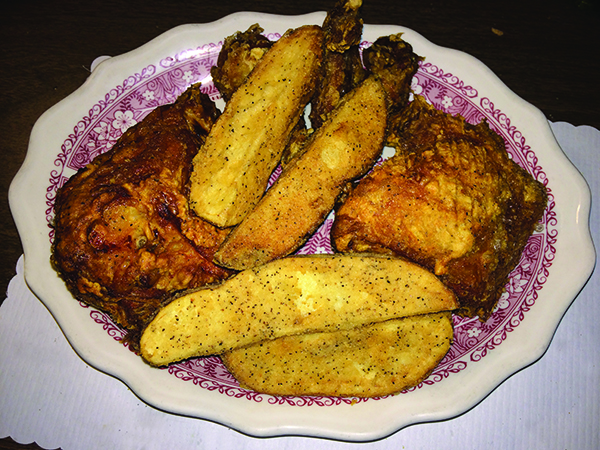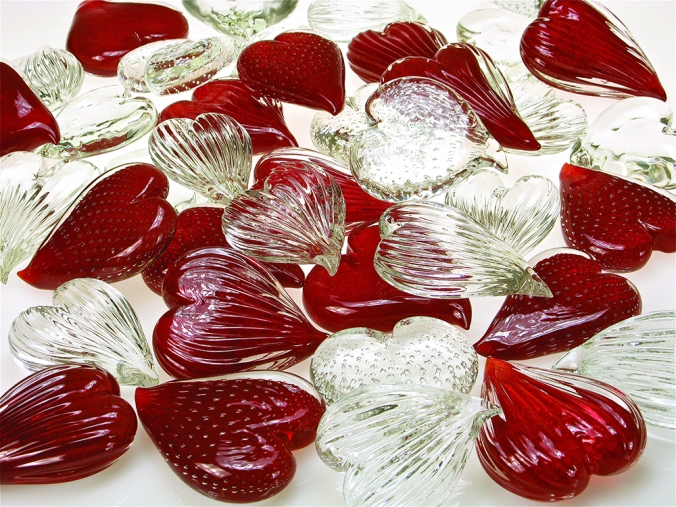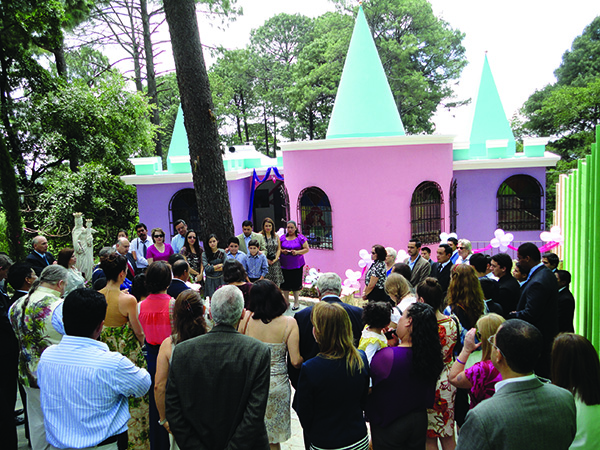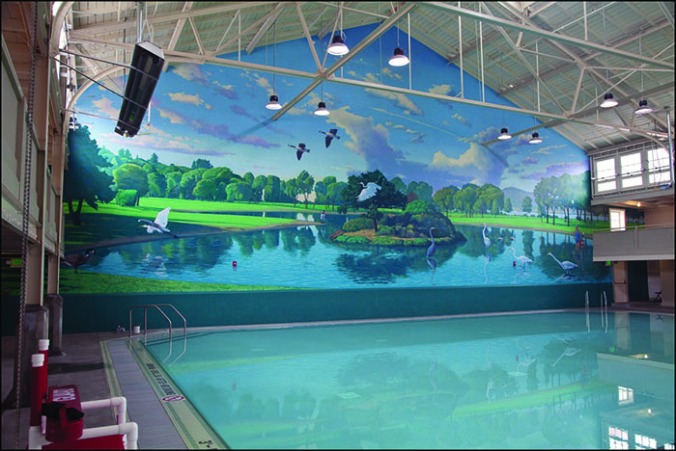
By Vickie Lewis
In today’s volatile economy, it is rare to find a privately owned restaurant that has been successful for 36 years and is still going strong! Such is the case of Ricky’s Corner, a family-friendly restaurant and lounge, located at the end of Parker Avenue in Rodeo. Although I’ve lived in West County my entire life, I’d never previously dined at Ricky’s, though I had heard many good things about it over the years. But now that I’ve experienced it personally, it is definitely on my list of “go to” establishments where I can enjoy a delicious dinner in a casual comfortable environment.
Ricky’s Corner was established by Ricky and Judy Bratton, who met when they were very young while both were working at the former Vera’s Villa Valona Italian Restaurant in Crockett. Judy’s mother was the head waitress at Vera’s at that time, and trained Judy, who started as a bus girl, to wait tables. After leaving Vera’s her parents became restaurateurs, and owned a couple of different businesses, including The Silver Dollar Restaurant, formerly located in El Cerrito. When Judy and Ricky were ready to open a restaurant of their own, her parents helped them get started. Ricky’s Corner was opened in 1978 at the very same location where it exists today. Sadly, Ricky passed away in 1995, but the establishment is still owned and operated by Judy and her family.
Ricky’s originally opened for lunch and dinner, but has only served dinner for the past fifteen years. It is often referred to as an Italian Restaurant, as their menu includes a half dozen Pasta entrees (including Ricky’s Homemade Cannelloni), as well as Chicken Caccitaore , Chicken Italiano, Veal Scallopini and Veal Parmesan. But there are also a variety of other non-Italian offerings, including seafood and beef entrees, pork chops, and one of Ricky’s specialties—beef liver and onions! They also feature 7 to 8 daily specials, which vary based on product availability. Some examples include Oysters, Sweetbreads, Cajun Snapper, as well as Prime Rib dinner (every Friday and Saturday.) Suffice to say, there is an ample variety of menu selections that will appeal to any appetite! Also important to note is that all entrees are served with soup AND salad, AND your choice of Mostaccioli, spaghetti, or French fries. Baked potatoes are available on Fridays and Saturdays. Not only is this a great value for the price, but you definitely won’t go away feeling hungry!
Ricky’s Corner is well-known for its Fried Chicken. They have their own special recipe that has become very popular with patrons over the years. You can order fried chicken as an entrée; however, small and large buckets of cooked-to-order fried chicken are also available for take-out (with or without garlic) and are served with large potato wedges, which appear to be the size of a quarter of a potato. Allow at least 30 minutes when ordering fried chicken to ensure it is hot and ready for pick-up.
Ricky’s also boasts a seasoned staff of cooks, wait staff and bartenders who are committed to providing fast and friendly customer service. Judy’s son, Ricky, Jr., is the full time head cook, having assumed the role after his father passed away. A second cook, Dennis, assists Ricky and has been with the restaurant for over 30 years. The bartenders, Lori and Lucille, have also been with Ricky’s since it opened. Several other long-time employees are on staff, and have come to know many of their customers personally. Judy still works at the restaurant at least two nights a week, and her daughter-in-law, Chris handles the business operations (in addition to working full time for the City of Hercules.) Ricky’s diners appreciate the consistency in the staff and the friendly service they receive, which has resulted in significant repeat business and regular customers.
Contrary to the name, you won’t actually find Ricky’s Corner on a “corner”— it’s actually in the middle of the street, just as Parker Avenue curves to the right toward the Union 76 Refinery. From the outside, the gray concrete building belies the fact that inside there is a great eatery. If not for the small lighted sign outside the lounge and the name “Ricky’s Corner” painted over the front entrance of the restaurant, it is easy to bypass this venue. Parking can be found along the street in front of and across from Ricky’s, and in the parking lots of adjacent businesses after business hours.
Upon entering the restaurant, it feels like you could be walking through the door of your grandmother’s house. Dark brown ceiling to floor paneling lines the walls which are adorned with an eclectic collection of floral paintings, other artwork, and signage. Fluorescent lighting is mounted on the ceilings, and each table adjacent to a wall is lighted by a small wall-mounted lamp. Wooden hutches, book cases, and shelving add to the décor and the “homey” feeling of the room. Wooden benches near the entrance, for patrons waiting to be seated or to pick up take-out, are reminiscent of church pews. In addition to a full-sized bar, the lounge includes additional tables where patrons can dine while watching a wall-mounted television. For additional entertainment, there is also a juke box, as well as a full-sized pool table and a Pac-Man arcade game.
My guest during this visit had dined at Ricky’s many times over the years, always with a positive experience. When we were seated with our menus, I perused the offerings for several minutes before deciding, while my guest selected a favorite entrée that she’d enjoyed before. We started with an appetizer of Deep Fried Mushrooms and Deep Fried Raviolis. These are listed individually on the menu, but our request for a half order of each was happily accommodated. My guest ordered the Steak Parmesan, breaded steak topped with melted cheese and mushroom gravy, and I decided on the Filet of Sole, batter dipped and grilled with almonds. It’s important to note that Ricky’s makes all of its own soups, salad dressings, and sauces in-house. Each day, two types of homemade soups are available—minestrone is served daily, but the other selection varies. On the night of our visit, my guest ordered the Navy Bean Soup, and I ordered the Minestrone. For our salads, we had our choice of four homemade dressings—Blue Cheese, Ranch, Italian, and Thousand Island.
While waiting, we enjoyed fresh sourdough bread, and enjoyed our refillable beverages, Iced Tea and Diet Coke, which were served in tall glasses. The appetizers arrived promptly and were quite excellent! There was a generous portion of both the mushrooms and raviolis, fried crisp with a light, seasoned batter. The mushrooms were our favorite, but the raviolis were also very good. Soups were served next in cup-sized portions. The minestrone tasted very fresh with lots of well-cooked vegetables and shell pasta. My guest’s Navy Bean soup was reminiscent of the bean soup my grandmother used to make—thick and hearty with pieces of ham, very tasty, and not at all salty–the kind of soup that one could make a meal of! Our generously portioned salads included beets, cucumber slices, and delicious, crunchy homemade croutons.
When our entrees arrived, we were already full from all of the other items we’d eaten. So when the heaping plates arrived, we knew that take out containers would be required! My entrée included three pieces of sole with a generous serving of fresh, sliced almonds on top. My side of Mostaccioli with homemade marinara was just the right size and was cooked “al dente”. The sole was delicious, although the first couple of bites had a few small bones. But the remainder was bone-free, and I enjoyed it with tartar sauce and squeezed lemon. I also found that I enjoyed the crunchiness and flavor of the almonds on the sole, which I hadn’t had before. My guest’s steak parmesan was easily enough for two meals, accompanied by a large portion of spaghetti. I tried a bite of the steak, and it was quite tender and flavorful.
For dessert, I enjoyed Kahlua Parfait, vanilla ice cream, covered with Kahlua, topped with whipped cream. My guest indulged in the Strawberry Delight, which was vanilla ice cream, strawberries, and whipped cream. Ricky’s also offers several other ice cream dessert choices, as well as Chocolate Mousse and Cheesecake. The ice cream desserts were a light culmination to the meals we had just enjoyed.
Ricky’s is also a great place for family dining, and offers a Children’s Menu for those 12 and under, with prices ranging from $7.25 to $8.50 for entrée, sides, and drink. Prices on the regular menu range from $3.75 to $9.25 for appetizers and $13.95 to $18.95 for entrees. All menu items are also available for take-out. Ricky’s is very popular, having developed a regular following during its long tenure in Rodeo, so it can get often get quite busy, especially on weekends. Reservations are gladly accepted.
If you have not discovered Ricky’s Corner, I strongly encourage you to give it a try the next time you are seeking a new place to dine. Although the décor may seem a bit old-fashioned (because that’s the way the regulars like it), you will find friendly people committed to good, old-fashioned customer service, which is often hard to find these days. I’m sure that you, like me, will find that Ricky’s Corner is a hidden gem in West County and will want to return again and again.






